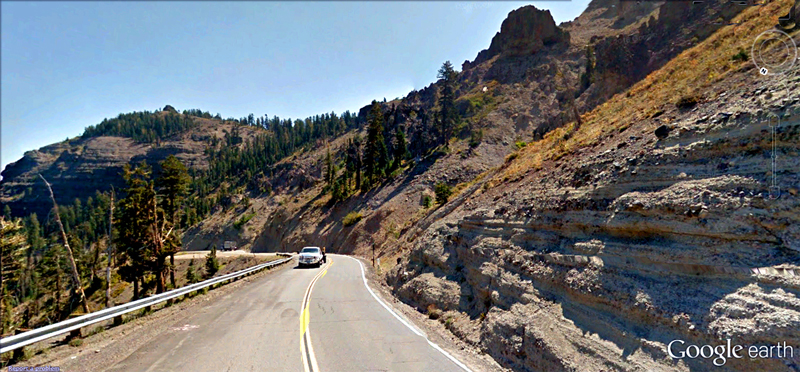



|
Top to bottom--Views to two fossil plant localities in the Carson Pass area, Sierra Nevada, California, in addition to a third place of interest in the Carson Pass district----all three of which can be visited along the route to the upper Miocene Disaster Peak Formation plants in the High Sierra Nevada, Alpine County, California. Top--A roadcut in the Carson Pass area that exposes an unnamed middle Miocene unit, dated by radiometric methods (radioactive isotope analyses) at 14.7 million years old; locally in the Carson Pass district this specific rock formation produces abundant petrified woods. It's primarily a combination volcanic debris flow/braided stream deposit, with common inclusion clasts that might represent repeated avalanches. A Google Earth street car perspective that I edited and processed through photoshop. Middle--A view southward near Carson Pass to a Sierra Nevada spectacle--and, a famous fossil leaf locality--a site the late paleobotanist Daniel I. Axelrod (July 16, 1910--June 2, 1998) had under formal scientific investigations for at least four decades. That patch of shale and sandstone at lower right yields common fossil leaves from an unnamed middle Miocene geologic rock unit usually calculated at around 16 million years old (originally thought to represent the Miocene Relief Peak Formation); the paleobanically significant sedimentary detritus accumulated in streams and as hyperconcentrated flood deposits. Elevation here is around 9,200 feet, above the local timberline. Note patches of lingering snow; photograph taken during a late August visit. The middle Miocene leaf locality near Carson Pass yields a chiefly riparian association whose modern day counterparts in general live at elevations no higher than 2,500 feet. Taxa dominants include the leaves of maple (Acer), tupelo (Nyssa), sycamore (Platanus), avocado (Persea), poplar (Populus), lingnut (Pterocarya), Catalina Ironwood (Lyonothamnus--a tree that presently grows in the wild only on the Channel Islands off the coast of southern California), oak (Quercus), elm (Ulmus), and willow (Salix); interestingly, no conifers occur in the so-called Carson Pass Flora. Today, the fossil site lies in the arctic-alpine zone of fell-fields and meadowland, above a subalpine forest of whitebark pine and mountain hemlock. Bottom--Frog Lake (elevation 8,865 feet) in the vicinity of Carson Pass. Near here--on July 16, 1998--a group of family and friends spread the ashes of paleobotanist Daniel I. Axelrod on the anniverary of what would have been his 88th birthday. |